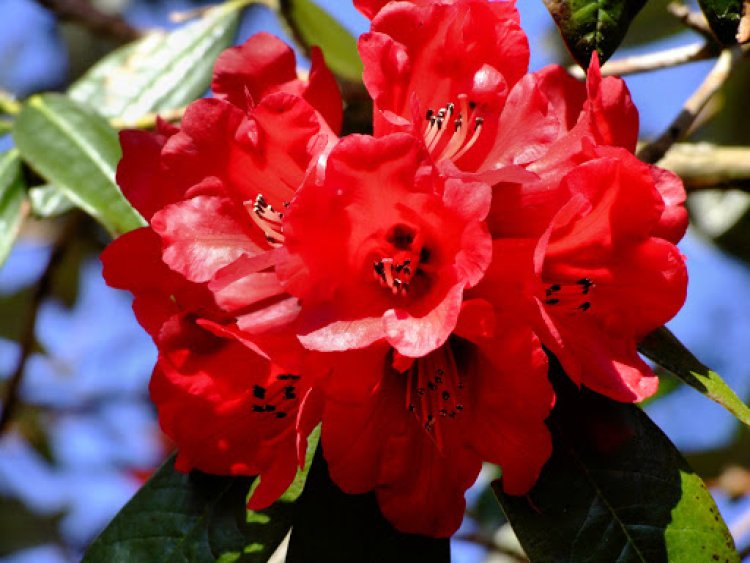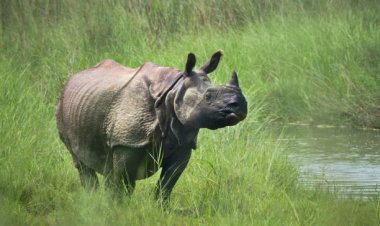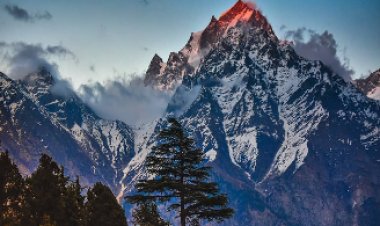Rhododendron: National Flower of Nepal
Discover Nepal's emblematic Rhododendron, a blooming treasure on Himalayan trails. Dive into nature's palette, culture, and conservation endeavors in these vibrant treks.

Nepal, a landlocked country nestled in the heart of the Himalayas, is renowned for its breathtaking landscapes, rich cultural tapestry, and diverse flora and fauna. Among the myriad of natural wonders that adorn this Himalayan nation, the rhododendron stands out as a symbol of beauty, resilience, and national pride. Declared the national flower of Nepal, the rhododendron, locally known as Gurans or Lali Gurans, holds a special place in the hearts of the Nepalese people and graces the country's lush hillsides with its vibrant blooms.
Botanical Splendor: The Rhododendron Species
The name "rhododendron" originates from the Greek words "rhodos", meaning rose, and "dendron", meaning tree. This genus encompasses a vast array of flowering plants, including both shrubs and trees, known for their large, showy flowers. With over 1,000 natural species and countless hybrids, rhododendrons have become a common garden plant worldwide. However, it is in the high Himalayan regions of Tibet, Nepal, and Bhutan, where these botanical wonders find their most diverse and stunning expression.
The biodiversity hotspots of Indo-Burma and South Central China, characterized by high rates of habitat destruction, are home to a plethora of rhododendron species. The rugged terrain and varying elevations create the perfect conditions for these plants to thrive. Rhododendrons are particularly prevalent at altitudes above 1,500 meters, transforming the landscapes into a riot of colors and shapes.
National Pride: Rhododendron in Nepalese Culture
In Nepal, the rhododendron holds not only botanical significance but also cultural and economic importance. The national flower, Rhododendron arboreum, locally known as Lali Gurans, is an impressive tree species that can reach heights of approximately 20 meters. The brilliance of its red flowers makes it a striking feature of the Himalayan flora.
Lali Gurans is deeply embedded in Nepalese culture and traditions. It finds a place in the Nepali food menu, where villagers consume the flower petals directly or incorporate them into dishes with rice and curry. The vibrant blooms are also used to create a sweet drink, showcasing the versatility of this national symbol.
Floral Elegance: Trekking Amidst Rhododendron Forests
One of the most enchanting ways to experience the beauty of rhododendrons in Nepal is through trekking. The country offers a myriad of trekking routes that wind through rhododendron-filled landscapes, providing trekkers with a visual feast of colors and fragrances. These treks, often at higher elevations, lead adventurers through forests adorned with moss-covered branches, shiny evergreen leaves, and, of course, the magnificent rhododendron flowers.
The best time to witness this floral spectacle is during the blooming season, which typically spans from March to early May, depending on the species and weather conditions. The treks that showcase the diversity of rhododendron species include Milke Danda Region, Langtang Valley, Poon Hill, and Ghandruk in Nepal. Eastern and Southern Tibet, near the Yunnan Province border, and Bhutan's Druk Path and Genty Trek also offer opportunities to encounter charismatic rhododendron species.
Diversity in Bloom: Rhododendron Species in the Himalayas
The trekking routes expose visitors to various rhododendron species, each with its unique characteristics. Among the common species encountered during treks in Nepal, Tibet, and Bhutan are rhododendron arboreum, rhododendron campanulatum, rhododendron campylocarpum, rhododendron falconeri, rhododendron grande, and rhododendron forrestii.
Rhododendron arboreum, the national flower of Nepal, stands tall with brilliant red flowers, reaching heights of around 20 meters. On the other hand, rhododendron campanulatum boasts purple, white, or blue flowers in bundles and grows to approximately 5 meters. The diminutive rhododendron forrestii, found at very high elevations, forms small mounds with bright red flowers, creating a breathtaking contrast to its modest size.
The diversity of rhododendron species varies not only in size but also in the colors and shapes of their blooms. Trekking enthusiasts and avid birders can relish the experience of witnessing these botanical wonders and encountering bird species that frequent the rhododendron forests.
Identifying Rhododendron Species: A Pocket Guide
For those keen on identifying rhododendron species during their trekking adventures, a valuable resource is the "Pocket Guide to Rhododendron Species" by McQuire and Robinson. This guide provides clear descriptions and stunning photographs of each species, enhancing the trekking experience by adding an educational dimension to the journey.
Trekking Destinations: A Symphony of Colors
The beauty of rhododendron treks lies not only in the diverse species encountered but also in the trekking destinations that showcase these floral wonders. Some of the best trekking regions for rhododendron enthusiasts include:
- Milke Danda Region: Known for its 30 species of rhododendron, Milke Danda is a haven for nature lovers. Trekkers can explore Teenjura, Milke, and Jajale, experiencing the capital of rhododendron in the nation.
- Langtang Valley: A trek through Langtang Valley treats visitors to extensive rhododendron forests along rocky ridges, offering a captivating display of colors.
- Poon Hill: Famous for the Ghorepani Poon Hill Trek, this region is adorned with rhododendron blooms in March and April, creating a spectacular landscape.
- Ghandruk: Nestled in the Annapurna region, Ghandruk offers a picturesque setting with rhododendrons enhancing the natural beauty of the landscape.
- Eastern and Southern Tibet: The border areas with Yunnan Province provide opportunities to witness unique rhododendron species against the backdrop of rugged terrains.
- Druk Path and Genty Trek in Bhutan: Bhutan's treks, such as the Druk Path and Genty Trek, lead through gnarled rhododendron forests, showcasing the country's natural beauty.
These destinations not only offer a visual feast of rhododendron blooms but also provide trekkers with a chance to immerse themselves in the unique ecosystems of the Himalayan region.
Beyond Rhododendrons: Botanical Treasures of Nepal
While trekking through Nepal, Bhutan, or Tibet to witness rhododendron blooms, one can also encounter other botanical treasures that add to the richness of the journey. The Himalayan spruce, tiny gentians, pedicularis (broomrape), and the elusive snow lotus (saussurea), a valuable and endangered medicinal plant, contribute to the diverse flora found nowhere else in the world.
The trekking experience in these regions becomes a holistic journey, combining the appreciation of diverse plant life, encounters with unique wildlife, and immersion in the rich cultural traditions of the local communities.
Rhododendron Conservation Efforts: Preserving Natural Heritage
Given the ecological importance and cultural significance of rhododendrons in the Himalayan region, various conservation initiatives have been undertaken to protect these floral wonders. The Rhododendron Conservation Program in Nepal, supported by organizations such as the World Wildlife Fund (WWF), focuses on preserving the habitats of rhododendron species while promoting sustainable tourism practices.
Efforts to raise awareness about the importance of conserving rhododendrons extend beyond national borders. Collaborative initiatives involving local communities, government bodies, and international organizations aim to safeguard these botanical treasures for future generations.
Rhododendron: A Source of Health and Traditions
Beyond its aesthetic appeal, the rhododendron holds medicinal properties that have been recognized and utilized by the indigenous communities of the Himalayas for generations. The red petals of the rhododendron flower are considered a natural painkiller, and the plant is used in traditional medicine to treat various ailments, including heart disease, inflammation, constipation, bronchitis, and asthma.
In the traditional culture of Nepal's Himalayan region, rhododendron flowers are processed into powders used in pickles, adding both flavor and health benefits. The bioactive steroids and phytochemicals present in rhododendrons contribute to their antifungal, antioxidant, and antimicrobial properties.
Cultural Significance: Rhododendron in Art, Music, and Festivals
The influence of rhododendrons extends beyond the realms of nature and medicine into the cultural tapestry of the Himalayan communities. The vibrant red blooms find expression in art, music, and festivals, becoming a source of inspiration for poets and musicians alike.
Numerous poems and songs, such as "Timi Lali Gurans Phule Jastai" and "Ma Ta Laligurans Bhayechu", celebrate the beauty of the rhododendron. Women adorn their hair with rhododendron flowers, and the blossoms are used to decorate houses, particularly during festivals and special occasions.
The rhododendron holds a special place in the rituals and festivities of the Himalayan communities. The Helambu District, for example, celebrates the Lali Gurans Festival during the peak flowering season, creating a vibrant and joyous atmosphere.
Conclusion
In conclusion, the rhododendron, the national flower of Nepal, is not merely a botanical specimen; it is a symbol of resilience, cultural richness, and the inherent connection between nature and human communities. The trekking routes that wind through rhododendron-filled landscapes offer not only a visual spectacle but also a profound connection with the ecosystems and traditions of the Himalayan region.
As travelers embark on these treks, they not only witness the kaleidoscope of colors that the rhododendron forests provide but also contribute to the ongoing efforts to conserve and protect these natural wonders. Rhododendron treks in Nepal, Bhutan, or Tibet transcend the boundaries of a typical adventure; they become a symphony of nature, where every step echoes the vibrant spirit of the Himalayas and its floral ambassadors, the rhododendrons.
What's Your Reaction?





































































































